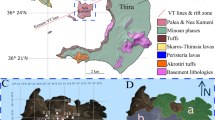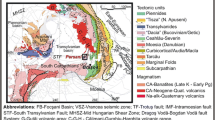Abstract
On the basis of historical chronicles and field investigations the tephrostratigraphic sequence of post-1631 activity of Vesuvius is reconstructed. It has been established that, during this period, in addition to numerous totally effusive eruptions and/or normal strombolian activity, 16 explosive events produced well-traceable tephra deposits in the area outside the Mount Somma caldera. Ages of tephra beds were established on the basis of stratigraphic relationships with historical lava flows and comparison with chroniclers information. The dispersal and lithological characteristics of tephra deposits combined with description of explosive activity lead to the identification of three styles: (a) periods of violent strombolian activity; (b) violent strombolian eruptions; and (c) subplinian eruptions. Violent strombolian eruptions and periods of discrete activity are characterized by the formation of lapilli falls from eruptive columns only some kilometers high. Subplinian eruptions are defined on the basis of their lapilli fall volumes which is of the order of 107 m3, on eruptive column heights of approximately 10 km, bt higher than 1.5, and mass discharged rate values not lower than 106 kg/s. During the first century of activity after the 1631 eruption, two periods of violent strombolian activity occurred at Vesuvius (1682–1707 and 1707–1719) preceded, and followed, by a series of violent strombolian eruptions (1660, 1682, 1707, 1723, 1730, 1790, 1872). Between 1730 and 1779 a relevant change in the eruptive style of Vesuvius occurred by an increase in the explosivity of the eruptions. During the past two centuries of activity, only a few eruptions reached subplinian magnitude and only five eruptions had a phreatomagmatic phase (1779, 1794, 1822, 1906, 1944). Therefore, the previously accepted model of cyclic activity, in which each cycle is closed by an important explosive eruption with phreatomagmatic characteristics, is unfounded. The tephrostratigraphy of the 1906 eruption proposed in this work differs substantially from some previous reconstructions, on which the basis for the modeling of Vesuvius’ behavior in this time span was formed.
Similar content being viewed by others
References
Amos RC, Self S, Crowe B (1981) Pyroclastic activity at Sunset Crater: evidence for a large magnitude, high dispersal strom-bolian eruption. EOS 62:1085
Andronico D, Cioni R, Sulpizio R (1996) General stratigraphy of the past 19.000 yr. IAVCEI-CEV/CMVD Vesuvius Decade Volcano 1996 Workshop Handbook
Arnò V, Principe C, Rosi M, Santacroce R, Sbrana A, Sheridan MF (1987) Eruptive history. CNR Quad Ricerca Sci 114(8):53–104
Barberi F, Cioni R, Rosi M, Santacroce R, Sbrana A, Vecci R (1989) Magmatic and phreatomagmatic phases in explosive eruptions of Vesuvius as deduced by grain size and component analysis of the pyroclastics deposits. J Volcanol Geotherm Res 38:287–307
Bertagnini A, Landi P Menga G, Santacroce R, Sbrana A (1987) La dinamica della eruzione Vesuviana del 1906 ricostruita sulla base delle cronache contemporanee e dello studio dei depositi piroclastici. Boll GNV 1987:109–144
Bertagnini A, Landi P, Santacroce R, Sbrana A (1991) From magmatic to phreatomagmatic activity through the flashing of a shallow depth hydrothermal system: the 1906 eruption of Vesuvius. Bull Volcanol 53:517–532
Bower SM, Woods AW (1996) On the dispersal of clasts from volcanic crater during small explosive eruptions. J Volcanol Geotherm Res 73:19–32
Brocchini D (1995) Estrazione dalle cronache storiche dei dati relativi al posizionamento delle fratture e delle bocche eruttive del Vesuvio nel periodo tra il 1631 al 1944. CNR prot 1377579, 14 pp
Carta S, Figari R, Sartoris G, Sassi E. Scandone R (1981) A statistical model for Vesuvius and its volcanological implications. Bull Volcanol 44:129–151
Cigolini C (1998) Thermobarometry of phlogopite-bearing dunitic enclaves from Mount Vesuvius: preliminary estimates. Acad Sci Torino Atti Sci Fis 131:109–132
Cigolini C, Riuffini R (1998) Le cumuliti clinopirosseniche associate ai depositi piroclastici Vesuviani (eruzione del 1944). Abstract volume XIV convegno scientifico annuale del GNV, 2–4 March, Catania, p 71
Cioni R, Sbrana A, Vecci R (1992) Morphologic features of juvenile pyroclasts from magmatic and phreatomagmatic deposits of Vesuvius. J Volcanol Geotherm Res 51:61–78
Cioni R, Marianelli P, Santacroce R, Sbrana A (2000) Plinian and subplinian eruptions. In: Sigurdsson H (ed) Encyclopedia of volcanoes. Academic Press, London, 477–494
Civetta L, Santacroce R (1992) Steady state magma supply in the last 3400 years of Vesuvius activity. Acta Vulcanol Marinelli 2:147–159
Cole PD, Queiroz G, Wallenstein N, Gaspar JL, Duncan AM, Guest JE (1995) An historic subplinian/phreatomagmatic eruption: the 1630 A.D. eruption of Furnas volcano, Sao Miguel, Azores. J Volcanol Geotherm Res 69:117–135
Cole PD, Guest JE, Queiroz G, Wallestein N, Pacheco JM, Gaspar JL, Ferreira T, Duncan AM (1999) Styles of volcanism and volcanic hazards on Furnas volcano, Sao Miguel, Azores. J Volcanol Geotherm Res 92:39–53
Cortini M, Scandone R (1982) The feeding system of Vesuvius between 1754 and 1944. J Volcanol Geotherm Res 12:393–400
Dolfi D, Trigila R (1978) The role of water in the 1944 eruption at Vesuvius. Contrib Mineral Petrol 67:297–304
Fierstein J, Nathenson M (1992) Another look at the calculation of fall tephra volume. Bull Volcanol 54:156–167
Francis P (1996) Volcanoes: a planetary perspective. Clarendon Press, London
Fulignati P, Marianelli P, Sbrana A. Guido L (1996) The 1944 eruption: overall description. IAVCEI-CEV/CMVD Vesuvius Decade Volcano 1996 Workshop Handbook
Fulignati P, Marianelli P, Sbrana A (1998) New insights on the thermometamorphic-metasomatic magma chamber shell of the 1944 eruption of Vesuvius. Acta Vulcanol 10:47–54
Hazlett RW, Buesch D, Anderson JL, Elan R, Scandone R (1991) Geology failure conditions and implications of seismogenic avalanches of the 1944 eruption at Vesuvius, Italy. J Volcanol Geotherm Res 47:249–264
Houghton BF, Wilson CJN, Pyle DM (2000) Pyroclastic fall deposits. In: Sigurdsson H (ed) Encyclopedia of volcanoes. Academic Press, London, pp 555–570
Johnston-Lavis HJ (1891) Geological map of Monte Somma and Vesuvius (1.10,000) constructed during the years 1880–1888. Philips and Son, London
Johnston-Lavis HJ (1909) The eruption of Vesuvius in April 1906. Scientific Transactions of the Royal Dublin Society S II Vol IX fasc 8
Joron JL, Métrien N, Rosi M, Santacroce R, Sbrana A (1987) Chemistry and petrography. CNR Quad Ricerca Sci 114(8): 105–174
Le Hon H (1865) Histoire complète de la grande éruption du Vésuve de 1631, with the topographic map of Vesuvius lavas from 1631 to 1861. Bull Acad R Belgique 2 (20)
Marianelli P, Métrien N, Santacroce R, Sbrana A (1995) Mafic magma batches at Vesuvius: a glass inclusion approach to the modalities of feeding stratovolcanoes. Contrib Mineral Petrol 120:159–169
Marianelli P, Métrich N, Sbrana A (1999) Shallow and deep reservoirs involved in magma supply of the 1944 eruption of Vesuvius. Bull Volcanol 61:48–63
Mastrolorenzo G, Munno R, Rolandi G (1993) Vesuvius 1906: a case study of paroxysmal eruption and its relation to eruption cycles. J Volcanol Geotherm Res 58:217–237
Nazzaro A (1998) Il Vesuvio: storia eruttiva e teorie vulcanologiche. Collana “Geofisica dell’ambiente e del territorio”. Liguori. Rome
Newhall CG, Self S (1982) The volcanic explosivity index (VEI): an estimate of explosive magnitude for historical volcanism. J Geophys Res 87:1231–1238
Pesce A, Rolandi G (1994) Vesuvio 1944 — l’ultima eruzione. Giglio di Scafati, Rome
Principe C, Brocchini D (1995) Fracturation pattern at Vesuvius during the 1631–1944 period. Per Mineral 64:225–256
Principe C, Rosi M, Santacroce R, Sbrana A (1987) Explanatory notes to the geological map. CNR Quad Ricerca Sci 114(8):11–52
Pyle DM (1989) The thickness, volume and grainsize of tephra fall deposits. Bull Volcanol 51:1–15
Rosi M, Santacroce R, Sbrana A (1987) Geological map of Somma-Vesuvius volcanic complex (scale 1:25,000). CNR PF Geodinamica L Salomone, Rome
Rosi M, Principe C, Vecci R (1993) The 1631 Vesuvius eruption. A reconstruction based on historical and stratigraphical data. J Volcanol Geotherm Res 58:151–182
Santacroce R, Bertagnini A, Civetta L, Landi P, Sbrana A (1993) Eruptive dynamics and petrogenetic processes in a very shallow magma reservoir: the 1906 eruption of Vesuvius. J Petrol 34:383–425
Scandone R, Malone SD (1985) Magma supply, magma discharge and readjustment of the feeding system of Mount St. Helens during 1980. J Volcanol Geotherm Res 23:239–262
Scandone R, Iannone F, Mastrolorenzo G (1986) Stima dei parametri dinamici dell’eruzione del 1944 del Vesuvio. Boll GNV 2:487–512
Self S (1976) The recent volcanology of Terceira, Azores. J Geol Soc Lond 132:645–666
Sieh K, Bursik MI (1986) Most recent eruption of the Mono Craters, eastern central California. J Geophys Res 91:539–571
Sparks RSJ, Bursik MI, Ablay GJ, Thomas RME, Carey SN (1992) Sedimentation of tephra by volcanic plumes. Part 2. Controls on thickness and grain size variations of tephra fall deposits. Bull Volcanol54:685–695
Sigurdsson H, Carey S, Cornell W, Pescatore T (1985) The eruption of Vesuvius in A.D. 79. Nation Geographr Res 1:332–387
Thorarinsson S, Sigvaldason GE (1971) The Hekla eruption of 1970. Bull Volcanol 36:269–288
Walker GPL (1973) Explosive volcanic eruptions: a new classification scheme. Geol Rundsch 62:431–446
Wilson L, Walker GPL (1987) Explosive volcanic eruptions VI. Ejecta dispersal in plinian eruptions: the control of eruption conditions and atmospheric properties. Geophys J R Astr Soc 89:657–679
Author information
Authors and Affiliations
Corresponding author
Additional information
Published online: 9 May 2001
Editorial responsibility: J. Gilbert
Electronic supplementary material to this paper can be obtained by using the Springer LINK server located at http://dx.doi.ore/10.1007/s004450Ì00l30
Rights and permissions
About this article
Cite this article
Arrighi, S., Principe, C. & Rosi, M. Violent strombolian and subplinian eruptions at Vesuvius during post-1631 activity. Bull Volcanol 63, 126–150 (2001). https://doi.org/10.1007/s004450100130
Received:
Accepted:
Issue Date:
DOI: https://doi.org/10.1007/s004450100130




